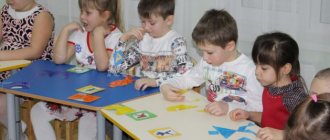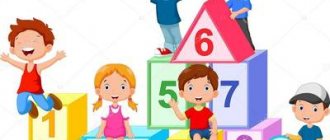Self-analysis of an open lesson with a psychologist (senior group)
Self-analysis of an open lesson with older children
"Land of Kind Words"
The correctional and developmental lesson is intended for children of senior preschool age.
The lesson was conducted with children of the older group.
There were 16 children present at the lesson: a girl and a boy.
Goals:
1. Develop the emotional sphere of children.
2. Create an emotionally-joyful mood as a result of joint activities.
3. Develop communication skills and moral qualities: the desire to help out a friend, to help in a difficult situation.
Tasks:
Educational
- To consolidate knowledge of the concepts of “goodness”, “kindness”, “good deed”, to consolidate polite words;
- Teach how to perform movements according to the model;
- Learn to engage in collective activities, taking into account the interests and opinions of other children;
- Introduce ways to relieve psychomuscular tension.
Educational:
- Develop emotional communication skills with each other.
- Develop empathy, attention, thinking, imagination, speech.
- Develop coordination of movements, sense of rhythm, orientation in space.
- Develop children's communication skills;
Educational:
- Foster friendly relationships between children, the desire to actively interact, help each other, and treat each other politely;
- Cultivate a desire to come to the aid of someone in trouble, the ability to take care of him.
When planning the lesson, the age characteristics of the children were taken into account, and the lesson was built based on the children’s knowledge. Previously, classes were held aimed at getting to know various emotions and feelings, and a conversation was held with children about good deeds and their meaning in a person’s life.
The structure of the lesson is built in such a way that children are completely immersed in the “journey”, and time flies by quickly and excitingly for them. Each stage of the lesson was accompanied by musical and visual accompaniment (a projector was used with illustrations selected according to their meaning).
At the beginning of the lesson, the “ball” exercise was used to unite the group and raise the emotional mood.
To attract interest in the activity and create a sense of empathy, a plot point was proposed with the disappearance of the “chest” and the proposal to find it for everyone together.
On the way to get the “chest,” various tasks awaited the children: they walked through a hurricane, completing the “Collect a flower” task, which contributes to the formation of group cohesion, the ability to work in small groups, the development of attention, visual-figurative thinking, and perception. The children also got caught in the rain of glue, but this did not stop them from overcoming obstacles together in the form of the very flowers that they had laid out (optimizes motor activity, coordination of movements, and the ability to navigate in space).
A change of activity in the form of psycho-gymnastics “Trees” contributed to consolidating the ability to focus on a model and developing reaction speed.
As a teaching moment, the game “Say a Word” was played on the topic of polite words. The children coped well with the task, choosing words that were appropriate in meaning.
After the active activity, the children switched to a creative task; using finger paints and a model, they created a beautiful “Tree of Friendship”, which later became a decoration for their group. Joint finger painting is a way not only to relax, become emotionally close and liberated, but also to develop fine motor skills, imagination and creative thinking.
At the end of the lesson, the children were invited to relax and immerse themselves in a sunny world where kindness and tranquility reign. After relaxation, all the children felt calm, muscle tension was relieved and it was time for a surprise moment: the children received “postcards” from the found chest with good wishes, which they later presented to their family and friends. Thus, the desire to bring joy to other people was aroused. On this note, the lesson came to an end. Standing in a circle, together with the children, the results of the lesson were summed up and the main result was made: only together, in a friendly, close-knit team, can we achieve something more, and friendship is the key to success!
Throughout the entire lesson, the children were captivated by the process, interested, and willing to complete the tasks. The pace of the lesson was optimal, the children completed the assigned tasks. The emotional state of the children remained positive throughout the lesson.
I believe that the set goal and objectives have been achieved. The lesson went according to plan and without unexpected difficulties.
Teacher-psychologist: Fionova S.P.
Psychological analysis of a lesson with a psychologist at a preschool educational institution, material on the topic
ANALYSIS OF A TEACHER'S ACTIVITY BY A PSYCHOLOGIST (according to L.T. Okhotina) ____________________
date ______________________________ _____________________________________________________________________
Group teacher / main teacher
| 1 | Availability of comprehensive – developmental, training, educational and correctional goals | |
| 2 | The content and structure of the lesson meets the principles: | |
| A) | Formation of a motivational basis for an activity (the ability to captivate children, the ratio of methods of inducing and coercing activities | |
| B) | Individual and differentiated approach | |
| IN) | The dynamism of children's perception (switching from different types of perceptual activity to others: from auditory to visual, kinesthetic, etc. | |
| G) | Development of higher mental functions | |
| D) | Using different types of teaching aid (imitation, model, verbal instruction, schematic plan, use of symbols) | |
| E) | Using gaming activities as the “outline” of the lesson | |
| 3 | To what extent is the load distributed? | |
| A) | For the memory of children and their thinking | |
| B) | To alternate emotionally rich and interesting, but difficult material; interesting but simple material; uninteresting and simple material; uninteresting and complex material | |
| IN) | To use reproductive and creative activities | |
| 4 | What techniques are used to prevent children from becoming overtired? | |
| 5 | Which parts of problem-heuristic learning are carried out by the teacher, and which by the children: | |
| A) | Who poses the problem | |
| B) | Who formulates it | |
| IN) | Who decides | |
| 6 | The teacher’s ability to combine collective, subgroup, paired and individual forms of work | |
| 7 | How do adults and peers compare the control, analysis and evaluation of children’s activities? What is the object of assessment of the teacher (knowledge, abilities and skills of children, their behavior, mutual assistance, etc.) | |
| 8 | Features of teacher self-organization: | |
| A) | Preparedness for the lesson (the degree of mastery of the content and psychological purpose of the lesson), internal readiness for the lesson (activity, determination, optimism, resourcefulness); working well-being at the beginning of the lesson and during its implementation | |
| B) | Pedagogical tact and teacher flexibility | |
| 9 | Psychological climate in the group: | |
| A) | How does the teacher support the atmosphere of communication between children and each other? | |
| B) | Type of relationship and style of communication | |
| 10 | Compliance of the time schedule for the lesson with the age category (mark in minutes) | |
| 11 | The presence of reflection (feedback) - how interesting it is for children (describe the moment) |
Conclusions, comments and recommendations for the lesson:
Teacher-psychologist Edemova E.R.
MBDOU "Solnyshko" p. Old Poltavka
Recommendations for analyzing lesson notes
The lesson summary should be drawn up based on a number of conditions. These include:
- The topic of the lesson should be adequate and optimal. It should help in the formation of UUD and be focused on the developmental potential of the educational session. In addition, the topic should reveal the place of the lesson in it, and in the study of the entire course of a particular discipline.
- Justification of the possibilities of the training session in the development of UUD, by including examples in the summary of the training session, i.e. the forms and methods of work in the lesson are described, which allow you to master the topic of the lesson and focus on the development of communication skills or contribute to the cognitive activity of students.
- The analysis of the manufacturability of the structure of a training session is carried out on the basis of special indicators. The assessment is based on the integrity of the lesson and the correspondence of the lesson content to its goals and objectives.
- Analysis of the outline begins with a detailed assessment of the components of the plan: their compliance with the requirements of the Federal State Educational Standard, focus on the comprehensive development of the student’s personality and achievement of the goals and objectives of the lesson. Therefore, the outline should be drawn up step by step. Each section of the outline must be reasonable and goal-oriented.
Finished works on a similar topic
Coursework Analysis of lesson notes 490 ₽ Abstract Analysis of lesson notes 280 ₽ Test paper Analysis of lesson notes 190 ₽
Receive completed work or specialist advice on your educational project Find out the cost
Lesson - as a form of educational activity
The lesson is the main form of the educational process in a modern school. Organizationally, a lesson is characterized by the certainty of the time allotted to it, the constancy of the composition of students, and is carried out according to a set schedule, mainly in a classroom (office) and in a collective form of education. A didactic lesson is characterized by the unity of the didactic goal, which unites the content of the activities of the teacher and students, and the definiteness of the structure, dictated each time by specific conditions and patterns of mastering educational material. As part of the educational process, a lesson may contain: organizational moment, perception, awareness and consolidation of information in memory; mastery of skills (based on acquired information) and experience of creative activity; mastering a system of norms and experience of emotional attitude to the world and activities in it; control and self-control of the teacher and students. At the same time, educational tasks are purposefully solved in each lesson. The following main types of lessons are usually distinguished: organizing the perception and assimilation of new knowledge; formation of skills and abilities; formation of experience in creative activity (or problem lesson); so-called combining lesson (combining the first 2 or 3 types). The traditional allocation of special lessons for consolidating knowledge and questioning students is unlawful: both are implemented in the assimilation of knowledge, the formation of skills and the creative application of knowledge.
A properly organized teaching and educational process in a lesson is characterized by features that do not depend on the composition of students, educational equipment, the personality of the teacher, etc.: the unity of the teaching and educational function of interaction between teacher and students, content and teaching aids; student activity; development of cognitive independence (i.e. the desire and ability to learn new things in the process of creative search); the unity of the didactic goal and the subordination of individual elements or parts of the lesson to it; construction of a lesson and its parts, taking into account the content of education, patterns of mastering educational material, teaching methods and the place of the lesson or part of it in the entire educational system (topic, section, course). The necessity of these features, which ensure the effectiveness of the lesson, reflects, on the one hand, the objectivity of the learning process, on the other, its dependence on the teacher’s awareness of the features of the content, patterns of learning, etc. (the subjective aspect of the learning process). At the same time, compliance with the requirements for the lesson does not limit the creativity of the teacher, the freedom of his methodological handwriting in accordance with the level of development and characteristics of student groups.
A lesson as a form of collective, frontal work with the class does not exclude group work - for tasks on independent acquisition and application of knowledge; practical work requiring collective efforts; to increase the activity of some students, etc. Group classes within the lesson are a certain form of individualization of learning along with individual assignments, providing students with a free pace to learn the material, and programming the actions of individual students.
To master the content of modern programs and related material, the lesson is supplemented with homework, which deepens the students’ knowledge and develops their skills of independent work and self-education.
Let us consider the analysis of the effectiveness of the lesson from the standpoint of the activity approach, the key point of which is the nature of the students’ activities.
In this case, the following main characteristics of the lesson are determined; purpose of activity, subject, content and methods of activity.




